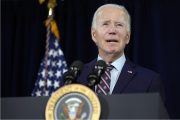
Deciding to move on following the failure of the Senate to pass the “skinny” ObamaCare repeal bill, the Trump administration announced on Monday its accelerated plans for passing its budget bill. According to Marc Short, President Trump’s director of legislative affairs, background work on the budget will take place in August in preparation for committee action in the House in September. Assuming little resistance there, Short hopes for a floor vote in October, a Senate vote in November, and the president’s signature on it immediately thereafter.
It’s good to dream big. The present reality is littered with obstacles, including the reality of mandatory spending taking up 70 percent of the budget, and Democrats having just tasted blood over its success in keeping ObamaCare afloat for a while longer.
First, the budget reality. The Fiscal Year budget for 2018 proposed $4.1 trillion in total spending. Revenues are estimated to be $3.6 trillion, creating a deficit estimated at close to $500 billion. That will be tacked onto the national debt already at a towering $20 trillion. And that deficit will likely be funded through more borrowing, adding to the interest the Treasury Department must pay.
Of that $4.1 trillion, $2.5 trillion is already committed — mandatory — for Social Security, Medicare, and Medicaid. Add in interest estimated at $315 billion, and that’s 70 percent of the budget already accounted for, about which the Trump administration can do next to nothing.
Which leaves just 30 percent to pay for the following: Department of Defense, Health and Human Services, Department of Education, the VA, Homeland Security, the National Nuclear Security Administration, the Justice Department, the State Department, and NASA.
Trump wants to increase the defense budget, build a wall on the southern border, and restore the nation’s infrastructure. He also wants to cut tax rates on individuals and companies in half, eliminate the estate tax, and lower taxes on U.S. businesses’ foreign earnings.
This pie can only be cut into so many pieces. So part of Trump’s sales pitch as he swings through the states to push his plan will be to grow the pie through tax cuts and faster write-offs of capital expenditures. He’s already lowered his GDP expectations from 4 percent a year to 3 percent in a hat tip to the present reality.
The other reality presented itself on Tuesday, with several apparently non-negotiable demands emanating from the newly rejuvenated Senate Democratic Caucus. In a letter signed by 45 of the 48 members of that caucus, they argued against tax cuts for the very rich — the top 1 percent — and demanded that Republicans not use “reconciliation” (fast-track rules) to speed up passage of any bill the House might send over. It also said they wouldn’t back any “deficit-financed” tax cuts (translation: no tax cuts).
Merriam-Webster defines “miracle” as “an extraordinary event manifesting divine intervention in human affairs.” At the moment, that appears to be the only way Trump is going to get anywhere close to keeping his budgetary promises.
Photo: Clipart.com
An Ivy League graduate and former investment advisor, Bob is a regular contributor to The New American magazine and blogs frequently at LightFromTheRight.com, primarily on economics and politics. He can be reached at [email protected].



